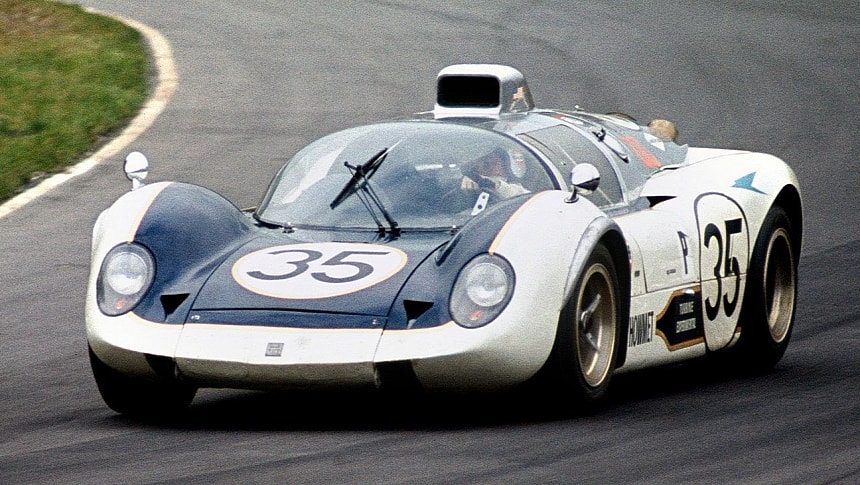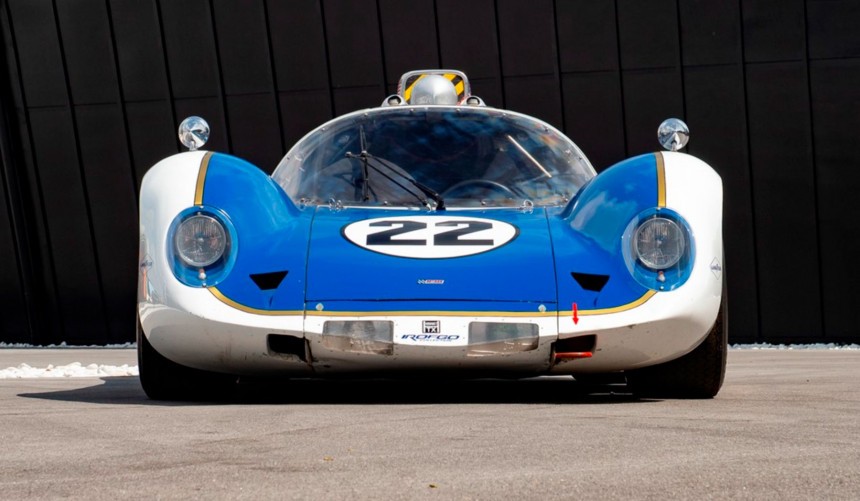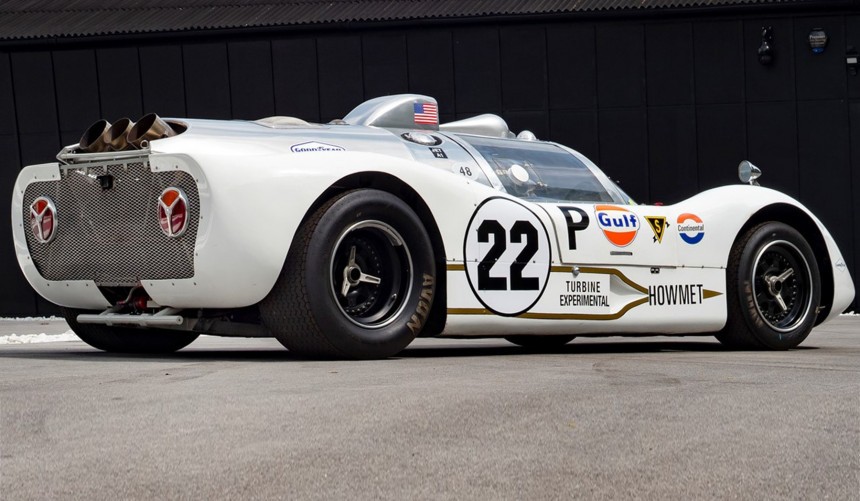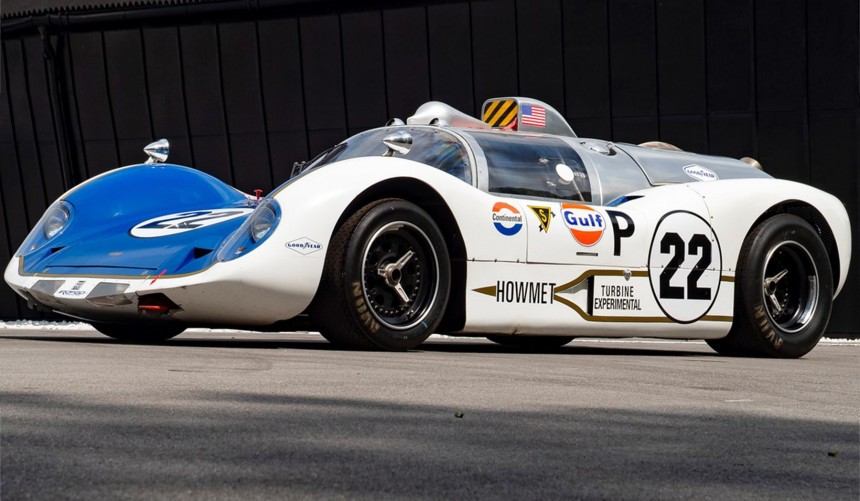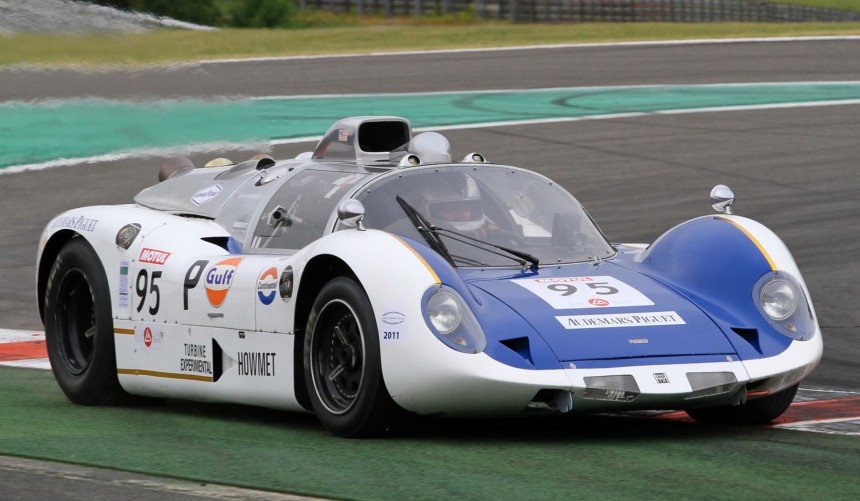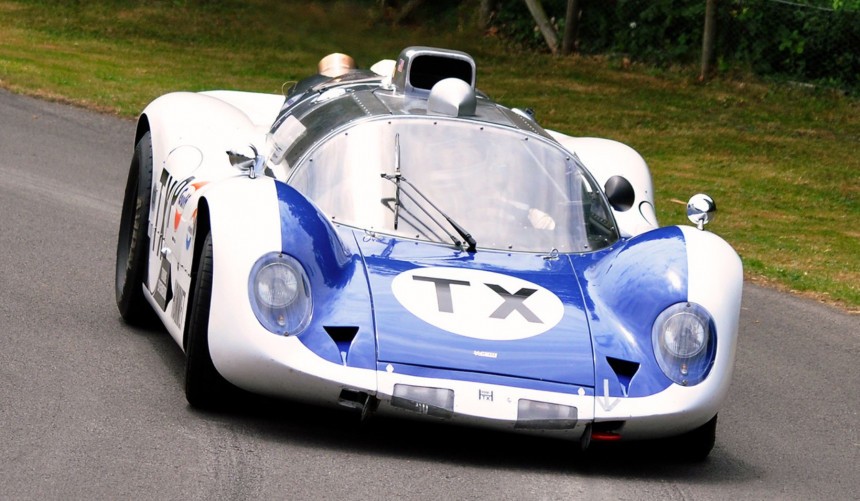In the late 1960s, John Wyer's Gulf-liveried GT40s added two more Le Mans wins to the legendary American race car's resume. During the same period, another US-built sports prototype became fascinating for motorsport enthusiasts all across the globe, mainly because it was powered by a gas turbine engine initially developed for a helicopter.
Shortly after the Second World War ended, the gas turbine engine became extremely popular in the aircraft industry.
Deemed revolutionary for its excellent power-to-weight ratio, compact packaging, and increased reliability compared to the era's traditional piston engines, the gas turbine was also seen as a viable alternative for the automotive industry.
Rover was the first carmaker to seriously experiment with this type of engine, creating the world's first fully functional, gas turbine-powered car.
Dubbed JET1, the innovative model never went past the prototype stage, but it did inspire several similar projects.
By the mid-1960s, Rover teamed up with British Racing Motors (BRM) and created a sports prototype that competed at Le Mans in 1964 and 1965.
In the US, the craze started by Rover encouraged Chrysler to take on its own gas turbine project, which resulted in the street-legal and extensively road-tested Turbine Car.
Though the Crysler project was scrapped after about a year of real-world testing, the idea of a gas turbine-powered car continued to fascinate several American enthusiasts, particularly those involved in motorsport.
One of those enthusiasts was Ken Wallis, a distant relative of famed British engineer Barnes Wallis. He initially pitched the idea of a gas turbine-powered race car to Dan Gurney and Carroll Shelby, both of whom dismissed it.
But Wallis didn't give up and got race car designer Andy Granatelli to turn his plans into reality. The fruit of their labor became the STP-Paxton Turbocar that competed at the 1967 Indy 500 with Parnelli Jones behind the wheel.
Around the same time when Wallis and Granatelli were developing the Turbocar, another motorsport die-hard began turning his dream of a gas-turbine race car into reality.
His name was Ray Heppenstall, and like Ken Wallis, he stubbornly refused to give up on his dream despite several refusals.
An active race driver, Heppenstall sketched out the plans for his turbine sports prototype, dreaming about going head-to-head with the likes of Ford's GT40.
However, he didn't have the means to source an engine, so he pitched his idea to the Allison Engine Company and Williams Research (among others), but none were willing to supply him with a turbine.
Heppenstall eventually got fellow race driver Tom Fleming to become interested in the project, and since the latter was the vice president of Howmet Corporation, he managed to help him source an engine.
The Howmet Corporation developed turbine castings for several aerospace manufacturers, including Continental Aviation & Engineering.
After being convinced that the out-of-the-box idea would work wonders for the corporation's image, particularly since the resulting car would bear the Howmet name, management helped Heppenstall source not one but two gas turbine engines from Continental.
Initially developed for use in a stillborn military helicopter prototype, the TS325-1 gas turbine weighed 170 pounds (77 kg) and delivered 350 hp as well as 650 lb-ft (880 Nm) of torque, which made it ideal for endurance racing-focused sports prototype.
Equipped with a wastegate to reduce lag, the gas turbine engine was able to rev up to a whopping 57,000 rpm, so it didn't require a conventional gearbox. Instead, a single-speed unit was installed.
However, the aim of the project was to build an FIA-homologated race car that could compete in the 1968 International Championship for Makes, and to earn homologation, it needed to feature a reverse gear.
To achieve that, Heppenstall and his crew installed a small electric motor that powered the car when backing up.
Officially called Howmet TX (Turbine eXperimental), the innovative American-built sports prototype should've been based on an existing Cooper Monaco chassis.
However, Heppenstall soon realized that in order to build a competitive race car, he needed a bespoke chassis.
The task was handed to Bob McKee and his McKee Engineering team, who used an existing Can-Am car for the first space frame chassis and then developed an improved version from scratch for the second TX.
Both structures featured fully independent suspension systems and four-wheel disc brakes, with the gas turbine engine standing between the rear axle and cockpit in a mid-ship position.
While the two chassis were slightly different, the bodywork for both TXs was identical. It was designed to comply with FIA Group 6 regulations and drew inspiration from the era's most aerodynamically advanced sports prototypes.
Both Howmet TX chassis were finished and tested in time for the 1968 International Championship for Makes opening round: the 24 Hours of Daytona.
However, the team chose to enter only the second car at the event, while the first was kept as a spare.
Co-driven by Dick Thompson, Ed Lowther, and Ray Heppenstall himself, the TX qualified seventh fastest overall. During the race, it surprised everyone by advancing into the top three, but a wastegate issue on lap 34 forced the team to retire.
A few weeks later, Howmet TX finished the qualifying session for the 12 Hours of Sebring in third place, behind a Porsche 907 and a Ford GT40.
However, during the race, debris scattered around the track ended up damaging the turbine, and the team had to retire with six hours remaining on the clock.
Another wastegate issue prevented the team to finish their first European event at Brands Hatch, so they decided to retire from the International Championship for Makes and focus on the SCCA National Championship back home.
This new adventure proved more successful, with two overall wins and several track records broken. The success gave the team the courage to return to Europe for the 1968 24 Hours of Le Mans, but the TX proved uncompetitive on the French track's long straights, qualifying twelve overall. To make matters worse, several issues prevented the car from finishing the actual race.
Though Heppenstall was determined to improve the design after the 1968 season was over, Howmet decided to pull out of the project, and the TX's racing career came to an abrupt end.
Per the initial contract, Howmet retained ownership of the two TXs and used them for promotional events. One of those events was held on the road next to Talladega Superspeedway in August 1970, where the second car fitted with an upgraded open-top body broke several land speed records for gas turbine-powered cars with Heppenstall behind the wheel.
A year later, Howmet sold the two cars to Heppenstall for the symbolic price of $1, but since the turbine engines were leased from Continental, they had to be returned.
Heppenstall kept the two engine-less chassis for several years, then sold them. Both switched owners several times and at one point, McKee Engineering built a third chassis that received an Allison turbine.
Today, both original cars are still around and were fully restored to 1968 spec. The first chassis currently features a rebuilt version of the original Continental engine, while the second also received an Allison unit.
Though it never became as successful as its designer had hoped, the Howmet TX remains the first gas turbine race car to ever win an official event and one of the most fascinating race cars ever developed in the US.
If you want to learn more about this forgotten turbine wonder, we recommend watching the following episode of Jay Leno's Garage.
Deemed revolutionary for its excellent power-to-weight ratio, compact packaging, and increased reliability compared to the era's traditional piston engines, the gas turbine was also seen as a viable alternative for the automotive industry.
Rover was the first carmaker to seriously experiment with this type of engine, creating the world's first fully functional, gas turbine-powered car.
Dubbed JET1, the innovative model never went past the prototype stage, but it did inspire several similar projects.
By the mid-1960s, Rover teamed up with British Racing Motors (BRM) and created a sports prototype that competed at Le Mans in 1964 and 1965.
In the US, the craze started by Rover encouraged Chrysler to take on its own gas turbine project, which resulted in the street-legal and extensively road-tested Turbine Car.
Though the Crysler project was scrapped after about a year of real-world testing, the idea of a gas turbine-powered car continued to fascinate several American enthusiasts, particularly those involved in motorsport.
Ray Heppenstall's dream-come-true
But Wallis didn't give up and got race car designer Andy Granatelli to turn his plans into reality. The fruit of their labor became the STP-Paxton Turbocar that competed at the 1967 Indy 500 with Parnelli Jones behind the wheel.
Around the same time when Wallis and Granatelli were developing the Turbocar, another motorsport die-hard began turning his dream of a gas-turbine race car into reality.
His name was Ray Heppenstall, and like Ken Wallis, he stubbornly refused to give up on his dream despite several refusals.
An active race driver, Heppenstall sketched out the plans for his turbine sports prototype, dreaming about going head-to-head with the likes of Ford's GT40.
However, he didn't have the means to source an engine, so he pitched his idea to the Allison Engine Company and Williams Research (among others), but none were willing to supply him with a turbine.
Heppenstall eventually got fellow race driver Tom Fleming to become interested in the project, and since the latter was the vice president of Howmet Corporation, he managed to help him source an engine.
From helicopter to race car
After being convinced that the out-of-the-box idea would work wonders for the corporation's image, particularly since the resulting car would bear the Howmet name, management helped Heppenstall source not one but two gas turbine engines from Continental.
Initially developed for use in a stillborn military helicopter prototype, the TS325-1 gas turbine weighed 170 pounds (77 kg) and delivered 350 hp as well as 650 lb-ft (880 Nm) of torque, which made it ideal for endurance racing-focused sports prototype.
Equipped with a wastegate to reduce lag, the gas turbine engine was able to rev up to a whopping 57,000 rpm, so it didn't require a conventional gearbox. Instead, a single-speed unit was installed.
However, the aim of the project was to build an FIA-homologated race car that could compete in the 1968 International Championship for Makes, and to earn homologation, it needed to feature a reverse gear.
To achieve that, Heppenstall and his crew installed a small electric motor that powered the car when backing up.
A state-of-the-art chassis
However, Heppenstall soon realized that in order to build a competitive race car, he needed a bespoke chassis.
The task was handed to Bob McKee and his McKee Engineering team, who used an existing Can-Am car for the first space frame chassis and then developed an improved version from scratch for the second TX.
Both structures featured fully independent suspension systems and four-wheel disc brakes, with the gas turbine engine standing between the rear axle and cockpit in a mid-ship position.
While the two chassis were slightly different, the bodywork for both TXs was identical. It was designed to comply with FIA Group 6 regulations and drew inspiration from the era's most aerodynamically advanced sports prototypes.
A short racing career
However, the team chose to enter only the second car at the event, while the first was kept as a spare.
Co-driven by Dick Thompson, Ed Lowther, and Ray Heppenstall himself, the TX qualified seventh fastest overall. During the race, it surprised everyone by advancing into the top three, but a wastegate issue on lap 34 forced the team to retire.
A few weeks later, Howmet TX finished the qualifying session for the 12 Hours of Sebring in third place, behind a Porsche 907 and a Ford GT40.
However, during the race, debris scattered around the track ended up damaging the turbine, and the team had to retire with six hours remaining on the clock.
Another wastegate issue prevented the team to finish their first European event at Brands Hatch, so they decided to retire from the International Championship for Makes and focus on the SCCA National Championship back home.
This new adventure proved more successful, with two overall wins and several track records broken. The success gave the team the courage to return to Europe for the 1968 24 Hours of Le Mans, but the TX proved uncompetitive on the French track's long straights, qualifying twelve overall. To make matters worse, several issues prevented the car from finishing the actual race.
Though Heppenstall was determined to improve the design after the 1968 season was over, Howmet decided to pull out of the project, and the TX's racing career came to an abrupt end.
The Howmet TX today
A year later, Howmet sold the two cars to Heppenstall for the symbolic price of $1, but since the turbine engines were leased from Continental, they had to be returned.
Heppenstall kept the two engine-less chassis for several years, then sold them. Both switched owners several times and at one point, McKee Engineering built a third chassis that received an Allison turbine.
Today, both original cars are still around and were fully restored to 1968 spec. The first chassis currently features a rebuilt version of the original Continental engine, while the second also received an Allison unit.
Though it never became as successful as its designer had hoped, the Howmet TX remains the first gas turbine race car to ever win an official event and one of the most fascinating race cars ever developed in the US.
If you want to learn more about this forgotten turbine wonder, we recommend watching the following episode of Jay Leno's Garage.
